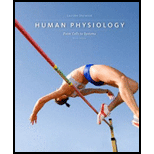
Human Physiology: From Cells to Systems (MindTap Course List)
9th Edition
ISBN: 9781285866932
Author: Lauralee Sherwood
Publisher: Cengage Learning
expand_more
expand_more
format_list_bulleted
Question
Chapter 5.9, Problem 1CYU
Summary Introduction
To write:
The roles of the brainstem.
Introduction:
The brainstem can be defined as the central stalk of the mammalian brain. It is the posterior part of the brain. It consists of three structures. It continues in a downward direction to form the spinal cord.
Expert Solution & Answer
Want to see the full answer?
Check out a sample textbook solution
Students have asked these similar questions
Standard Concentration (caffeine) mg/L
Absorbance Reading
10
0.322
20
0.697
40
1.535
60
2.520
80
3.100
Please draw in the missing answer, thank you
Please fill in all blank questions, Thank you
Chapter 5 Solutions
Human Physiology: From Cells to Systems (MindTap Course List)
Ch. 5.1 - Draw a flow diagram showing the organization of...Ch. 5.1 - Prob. 2CYUCh. 5.1 - Prob. 3CYUCh. 5.2 - Prob. 1CYUCh. 5.2 - Prob. 2CYUCh. 5.2 - Prob. 3CYUCh. 5.3 - Prob. 1CYUCh. 5.3 - Outline the components of the brain from the least...Ch. 5.3 - Prob. 3CYUCh. 5.4 - Prob. 1CYU
Ch. 5.4 - Prob. 2CYUCh. 5.4 - Prob. 3CYUCh. 5.4 - Prob. 4CYUCh. 5.5 - Prob. 1CYUCh. 5.5 - Prob. 2CYUCh. 5.5 - Prob. 3CYUCh. 5.6 - Prob. 1CYUCh. 5.6 - Prob. 2CYUCh. 5.6 - Prob. 3CYUCh. 5.7 - Prob. 1CYUCh. 5.7 - Prob. 2CYUCh. 5.7 - Prob. 3CYUCh. 5.7 - Prob. 4CYUCh. 5.8 - Prob. 1CYUCh. 5.8 - Prob. 2CYUCh. 5.9 - Prob. 1CYUCh. 5.9 - Prob. 2CYUCh. 5.9 - Prob. 3CYUCh. 5.10 - Prob. 1CYUCh. 5.10 - Prob. 2CYUCh. 5 - Prob. 1RECh. 5 - In emergencies when O2 supplies are low, the brain...Ch. 5 - Stellate cells initially process sensory input to...Ch. 5 - Prob. 4RECh. 5 - Prob. 5RECh. 5 - Prob. 6RECh. 5 - Prob. 7RECh. 5 - Prob. 8RECh. 5 - Prob. 9RECh. 5 - Prob. 10RECh. 5 - Prob. 11RECh. 5 - Prob. 12RECh. 5 - Prob. 13RECh. 5 - Discuss the function of each of the following:...Ch. 5 - Prob. 2UCCh. 5 - Prob. 3UCCh. 5 - Prob. 4UCCh. 5 - Prob. 5UCCh. 5 - Prob. 6UCCh. 5 - Prob. 7UCCh. 5 - Prob. 8UCCh. 5 - Prob. 9UCCh. 5 - Prob. 10UCCh. 5 - Prob. 11UCCh. 5 - Prob. 12UCCh. 5 - Prob. 13UCCh. 5 - Prob. 14UCCh. 5 - Distinguish between a monosynaptic and a...Ch. 5 - Julio D., who had recently retired, was enjoying...Ch. 5 - Prob. 1TAHLCh. 5 - Prob. 2TAHLCh. 5 - The hormone insulin enhances the carrier-mediated...Ch. 5 - Prob. 4TAHLCh. 5 - Under what circumstances might it be inadvisable...
Knowledge Booster
Learn more about
Need a deep-dive on the concept behind this application? Look no further. Learn more about this topic, biology and related others by exploring similar questions and additional content below.Similar questions
- please fill in missing parts , thank youarrow_forwardplease draw in the answers, thank youarrow_forwarda. On this first grid, assume that the DNA and RNA templates are read left to right. DNA DNA mRNA codon tRNA anticodon polypeptide _strand strand C с A T G A U G C A TRP b. Now do this AGAIN assuming that the DNA and RNA templates are read right to left. DNA DNA strand strand C mRNA codon tRNA anticodon polypeptide 0 A T G A U G с A TRParrow_forward
- Please identify the curve shown below. What does this curve represent? Please identify A, B, C, D, and E (the orange oval). What is occurring in these regions?arrow_forwardPlease identify the test shown here. 1) What is the test? 2) What does the test indicate? How is it performed? What is CX? 3) Why might the test be performed in a clinical setting? GEN CZ CX CPZ PTZ CACarrow_forwardDetermine how much ATP would a cell produce when using fermentation of a 50 mM glucose solution?arrow_forward
- Determine how much ATP would a cell produce when using aerobic respiration of a 7 mM glucose solution?arrow_forwardDetermine how much ATP would a cell produce when using aerobic respiration to degrade one small protein molecule into 12 molecules of malic acid, how many ATP would that cell make? Malic acid is an intermediate in the Krebs cycle. Assume there is no other carbon source and no acetyl-CoA.arrow_forwardIdentify each of the major endocrine glandsarrow_forward
arrow_back_ios
SEE MORE QUESTIONS
arrow_forward_ios
Recommended textbooks for you
 Human Physiology: From Cells to Systems (MindTap ...BiologyISBN:9781285866932Author:Lauralee SherwoodPublisher:Cengage Learning
Human Physiology: From Cells to Systems (MindTap ...BiologyISBN:9781285866932Author:Lauralee SherwoodPublisher:Cengage Learning Biology (MindTap Course List)BiologyISBN:9781337392938Author:Eldra Solomon, Charles Martin, Diana W. Martin, Linda R. BergPublisher:Cengage Learning
Biology (MindTap Course List)BiologyISBN:9781337392938Author:Eldra Solomon, Charles Martin, Diana W. Martin, Linda R. BergPublisher:Cengage Learning Medical Terminology for Health Professions, Spira...Health & NutritionISBN:9781305634350Author:Ann Ehrlich, Carol L. Schroeder, Laura Ehrlich, Katrina A. SchroederPublisher:Cengage Learning
Medical Terminology for Health Professions, Spira...Health & NutritionISBN:9781305634350Author:Ann Ehrlich, Carol L. Schroeder, Laura Ehrlich, Katrina A. SchroederPublisher:Cengage Learning Biology: The Dynamic Science (MindTap Course List)BiologyISBN:9781305389892Author:Peter J. Russell, Paul E. Hertz, Beverly McMillanPublisher:Cengage Learning
Biology: The Dynamic Science (MindTap Course List)BiologyISBN:9781305389892Author:Peter J. Russell, Paul E. Hertz, Beverly McMillanPublisher:Cengage Learning Human Biology (MindTap Course List)BiologyISBN:9781305112100Author:Cecie Starr, Beverly McMillanPublisher:Cengage Learning
Human Biology (MindTap Course List)BiologyISBN:9781305112100Author:Cecie Starr, Beverly McMillanPublisher:Cengage Learning

Human Physiology: From Cells to Systems (MindTap ...
Biology
ISBN:9781285866932
Author:Lauralee Sherwood
Publisher:Cengage Learning


Biology (MindTap Course List)
Biology
ISBN:9781337392938
Author:Eldra Solomon, Charles Martin, Diana W. Martin, Linda R. Berg
Publisher:Cengage Learning

Medical Terminology for Health Professions, Spira...
Health & Nutrition
ISBN:9781305634350
Author:Ann Ehrlich, Carol L. Schroeder, Laura Ehrlich, Katrina A. Schroeder
Publisher:Cengage Learning

Biology: The Dynamic Science (MindTap Course List)
Biology
ISBN:9781305389892
Author:Peter J. Russell, Paul E. Hertz, Beverly McMillan
Publisher:Cengage Learning

Human Biology (MindTap Course List)
Biology
ISBN:9781305112100
Author:Cecie Starr, Beverly McMillan
Publisher:Cengage Learning
Cell Differentiation | Genetics | Biology | FuseSchool; Author: FuseSchool - Global Education;https://www.youtube.com/watch?v=gwAz_BtVuLA;License: Standard YouTube License, CC-BY